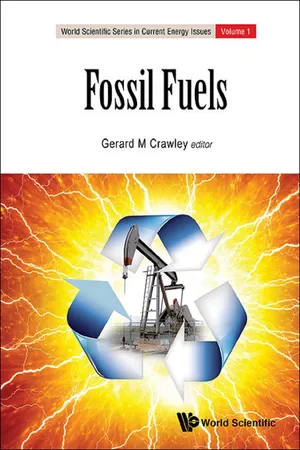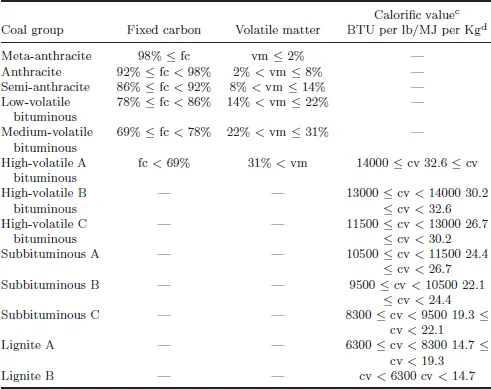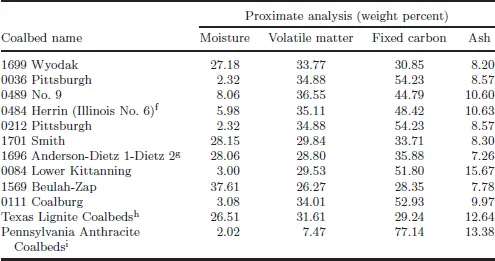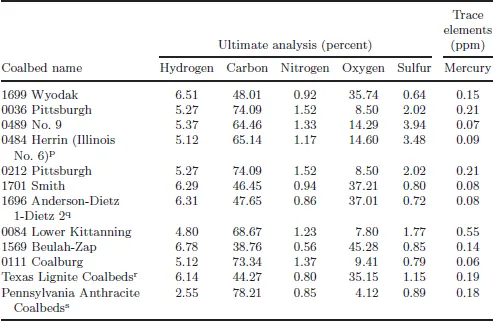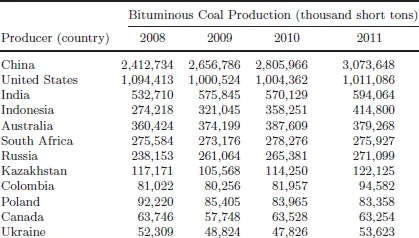![]()
Chapter 1
Coal Resources, Production, and Use Worldwide
Thomas Sarkus
National Energy Technology Laboratory
P.O. Box 0940, 626 Cochrans Mill Road, Pittsburgh, PA 15236
[email protected] William Ellis
KeyLogic Systems, Inc.
National Energy Technology Laboratory
P.O. Box 0940, 626 Cochrans Mill Road, Pittsburgh, PA 15236
This chapter introduces and describes coal as a widely available and versatile worldwide energy source. The chapter also contains a quick review of the origins of coal deposits and a ranking of different types of coal by energy and carbon content. The production and chemical analysis of coal from major US coalbeds (including representative values for some lignite and anthracite beds) are detailed. World coal resources, reserves, and production levels for coal types are discussed. Current and projected usage of coal by world region and selected countries is also presented. Selected internet-based coal information resources from the US Department of Energy and the International Energy Agency are referenced for reader use.
1Coal Basics
Coal is a rock of sedimentary origin, formed from decomposed and lithified biomass, and utilized widely as an energy resource. Coal is commonly termed a mineral resource, but according to a strict scientific definition, the term “mineral” denotes a fixed chemical composition whereas coal composition varies widely. Indeed, coal composition varies so much that samples taken from adjacent parts of the same coal seam can and do vary significantly in chemical composition. The complex composition of coal may vary both vertically and horizontally in a given coal bed or coal seam.
Fig. 1. Coal ranks (from least mature to most mature).
2Coal Rank
Coal is most commonly classified by rank. Coal rank increases as heat and pressure are applied over time through geologic processes. Accordingly, heating value (usually measured in Btu/lb. or MJ/kg) tends to increase and volatile compounds tend to decrease with higher rank; however, these are only trends, and do not necessarily apply in every instance. The ranks of coal are shown in Fig. 1, in order of increasing maturity.
Some experts do not consider peat, let alone biomass, to be a bona fide rank of coal, but at a minimum, they represent early precursors of the coalification process. Less mature ranks, such as lignite and subbituminous coal, often occur in very thick seams which can be surface mined. While underground subbituminous coal mines are not unknown, surface mining of subbituminous coal is overwhelmingly predominant. More mature ranks such as bituminous coal and anthracite usually occur in comparatively thinner seams and, while surface mining is performed in some circumstances, underground mining is commonly utilized to obtain these higher heating value coals. Peat, lignite, subbituminous coal, and bituminous coal generally occur in layers, beds, or seams that are more or less horizontal. Anthracite, however, undergoes a higher degree of alteration or metamorphism, so anthracite seams can be inclined sharply, or folded, through geologic processes.a The coal ranks can be divided into groups or sub-ranks, listed in Table 1, in descending order of maturity.
3Coal Analysis
There are numerous formats and techniques for analyzing coal owing partly to its use in a wide variety of applications over the past two centuries. Two of the most prevalent types of coal analyses are proximate analysis and ultimate analysis. Proximate analysis includes fixed carbon, volatile matter, ash, and moisture contents — all on an as-received basis. Ultimate analysis includes calorific or heating value (on both as-received and dry bases) as well as the amounts of carbon, hydrogen, nitrogen, oxygen, and sulfur. Other forms of coal analyses may include agglomerating or caking tendency, agglutinating or binding tendency, ash fusion temperature, ash softening temperature, free swelling index, Hardgrove grindability, petrography (e.g. maceral contents), trace element levels (often expressed as portions of either the parent coal or the ash fraction of the parent coal), and washability (or sink/float testing).
Table 1: Coal Ranks and Sub-ranks with Some Defining Parameters.b
Table 2 illustrates some typical proximate analysis for selected coalbeds. (These data tables are merely for illustrative purposes; readers are reminded that coal quality varies widely within any given coal seam or coal mine.) Table 3 shows representative coal caloric value by coalbed. Table 4 shows representative trace element analysis by coalbed.
Table 2: Coal Proximate Analysis by Coalbed.e
Table 3: Coal Caloric Value by Coalbed.j
| Calorific value |
| Coalbed name | Kcal/kg | Btu/lb. |
| 1699 Wyodak | 4641 | 8362 |
| 0036 Pittsburgh | 7379 | 13295 |
| 0489 No. 9 | 6496 | 11705 |
| 0484 Herrin (Illinois No. 6)k | 6441 | 11605 |
| 0212 Pittsburgh | 7379 | 13295 |
| 1701 Smith | 4376 | 7885 |
| 1696 Anderson-Dietz 1-Dietz 2l | 4509 | 8124 |
| 0084 Lower Kittanning | 6777 | 12212 |
| 1569 Beulah-Zap | 3563 | 6420 |
| 0111 Coalburg | 7262 | 13084 |
| Texas Lignite Coalbedsm | 4234 | 7628 |
| Pennsylvania Anthracite Coalbedsn | 6962 | 12544 |
Table 4: Trace Element Analysis by Coalbed.o
4World Coal Resources, Reserves, and Production Levels
Coal is distributed broadly across much of the United States and world. However, many coal deposits may be too small, too thin, or too deep to mine economically. As technology improves, it may become possible to mine or otherwise utilize (e.g. through well-controlled underground combustion or gasification) some of these coals. In other cases, coal seams may underlie cities, towns, or sensitive environmental areas.
Coal resources are significant both domestically and internationally. Exploration and estimation of coal resources does not carry the same level of risk and uncertainty as oil and natural gas exploration. One must, however, exercise caution when discussing resources and reserves (e.g. comparing recoverable coal reserves to recoverable oil and/or natural gas reserves) as the terminology can have rather precise meaning(s).
The US Energy Information Administration (EIA) defines recoverable coal as “Recoverable Reserves of Coal: An estimate of the amount of coal that can be removed (mined) from the accessible reserves in the future, using current prices and operable equipment.”
Worldwide recoverable coal reserves as of 2008 are shown for world regions in Table 5 and for the top 20 countries in Table 6. The United States has the largest coal reserves, followed by Russia, China, Australia, and India.
In similar fashion, Tables 7 and 8 illustrate total coal production over the 2008–2011 time period by world regions and top 20 countries, respectively. Tables 9–11 illustrate the production of bituminous coal, anthracite, and lignite, respectively. These production statistics were also drawn from the EIA International Energy Statistics Database.
Table 5: Recoverable Total Coal Reserves by Region,t 2008.u
Table 6: Recoverable Total Coal Reserves by Country, 2008.w
Table 7: Total Coal Production by World Region, 2008–2011.x
Table 8: Total Coal Production by Country, 2008-2011.y
Table 9: Bituminous Coal Production by Country, 2008–2011.z
Table 10: Anthracite Production by Country, 2005–2009.aa
Table 11: Lignite Production by Country, 2008–2011.bb
China is the leading producer of bituminous coal and anthracite as well as the leading overall producer. Germany leads in the production of lignite. These recoverable reserve statistics were draw...
